In the dynamic world of digital marketing, choosing the right SEO tool can significantly impact your online visibility and success. The debate between Semrush vs. Serpstat is a hot topic among marketers seeking to enhance their SEO strategies. Both platforms offer robust features designed to improve your search engine rankings, understand your competition, and refine your content strategy.
However, with each tool boasting its unique strengths and functionalities, it can be challenging to determine which is the best fit for your needs. This blog post aims to provide a detailed comparison of Semrush and Serpstat, covering key aspects such as features, integration capabilities, user interface, customer support, and user reviews. By exploring these areas, we hope to offer a balanced perspective that will help you make an informed decision in the Semrush vs. Serpstat debate.
Before we delve into the intricate details of Semrush vs. Serpstat, let’s briefly reflect on our recent exploration of SpyFu vs. Semrush, which shed light on the critical competitive intelligence features vital to any SEO strategy. Building upon that analysis, we now turn to how Semrush, previously benchmarked against SpyFu, stands up to Serpstat. This examination will not only broaden our understanding of Semrush’s versatility but will also introduce us to the distinct capabilities of Serpstat. With this comprehensive backdrop, we’ll dissect how each tool could potentially lead the digital marketing arena.
Table of Contents
Quick Comparison: Semrush vs. Serpstat
In the competitive landscape of SEO tools, the debate between Semrush vs. Serpstat is one that captures the attention of digital marketers seeking the most effective strategies to enhance their online presence. Semrush, with its comprehensive database and advanced analytical capabilities, offers an in-depth look into competitor strategies, keyword research, and site audits, making it a preferred choice for those who delve deeply into SEO metrics. On the other side of the Semrush vs. Serpstat comparison, Serpstat presents itself as a cost-effective alternative with robust features for site visibility analysis, backlink tracking, and keyword optimization, catering to small businesses and startups looking for quality SEO tools without breaking the bank.
The usability and pricing structure of these tools further intensify the Semrush vs. Serpstat discussion. Semrush boasts an intuitive interface that facilitates ease of use, allowing SEO professionals to quickly leverage its features to the fullest. Despite its higher price point, the depth of analysis and breadth of data it offers justify the investment for many. Conversely, Serpstat’s more affordable pricing model and valuable SEO functionalities make it an attractive option for those with tighter budgets, even though users might face a slightly steeper learning curve to fully exploit its offerings.
In conclusion, the Semrush vs. Serpstat debate hinges on the specific needs, budget considerations, and personal preferences of each user. Whether it’s Semrush’s extensive toolset and detailed insights or Serpstat’s affordability and effective SEO solutions that appeal more, both platforms provide significant value to their users. Making a choice between Semrush and Serpstat involves weighing these factors carefully to select the tool that best aligns with your SEO objectives and resource availability, ensuring your digital marketing strategy is as effective as possible.
Princing Plans
When evaluating the best SEO tool for your business, understanding the pricing plans is crucial. The comparison between Semrush vs. Serpstat in terms of pricing reveals significant differences that cater to various budgets and requirements. Here’s a detailed look, with added price values, at how these two platforms stack up:
Semrush Pricing Overview
Semrush offers a tiered pricing structure designed to accommodate the needs of freelancers, SMEs, and large enterprises.
- Pro Plan: Ideal for freelancers, startups, and in-house marketers with a limited budget. Provides access to over 40+ advanced tools for SEO, social media, and content marketing. Pricing: $129.95/month
- Guru Plan: Best suited for SMEs and growing marketing agencies. Offers all the Pro features plus content marketing platform, historical data, and more. Pricing: $249.95/month
- Business Plan: Designed for agencies, E-commerce projects, and businesses with extensive web presence. Includes all Guru features, API access, and Google Data Studio integration. Pricing: $499.95/month

Serpstat Pricing Overview
Serpstat’s pricing model is also tiered, aimed at being accessible to freelancers, small businesses, and large agencies.
- Individual: Perfect for individual users and freelancers. Offers basic SEO and PPC analysis, keyword and competitor research tools. Pricing: $59/month
- Team: Geared towards small teams and businesses. Includes all Lite features plus extended limits and API access. Pricing: $119/month
- Agency: Offer advanced features for larger teams and agencies, including team management capabilities and priority support. Pricing: $479/month

Key Differences in Pricing
- The primary difference in the Semrush vs. Serpstat pricing debate is that Semrush tends to be on the higher end of the spectrum, reflecting its comprehensive toolset and larger database.
- Serpstat is more budget-friendly, making it an attractive option for users who need solid SEO functionalities without the extensive toolkit that Semrush provides.
Keyword Research
Keyword research is a foundational aspect of SEO, guiding content strategy and helping to ensure your website ranks well in search engine results. In the Semrush vs. Serpstat battle, both platforms offer powerful tools to aid in this crucial task, but there are distinct differences in their approaches and capabilities. Here’s an overview to help you understand how each tool can support your keyword research efforts:
Semrush Keyword Research Features
- Offers an extensive keyword database with over 20 billion keywords.
- Provides detailed keyword analytics, including volume, difficulty, CPC, and competitive density.
- The Keyword Magic Tool helps users easily find long-tail keywords and question-based queries, facilitating topic discovery.
- Offers keyword gap analysis, allowing you to compare your keyword profile with competitors to find opportunities.

Serpstat Keyword Research Features
- Features a robust keyword database tailored for Google and Yandex, with detailed insights into search volume, competition, and visibility.
- Specializes in keyword clustering and text analytics to improve content relevance and SEO effectiveness.
- Provides search suggestions and related questions for comprehensive content planning.
- The Keyword Trends feature highlights popular keywords and their search trends over time.
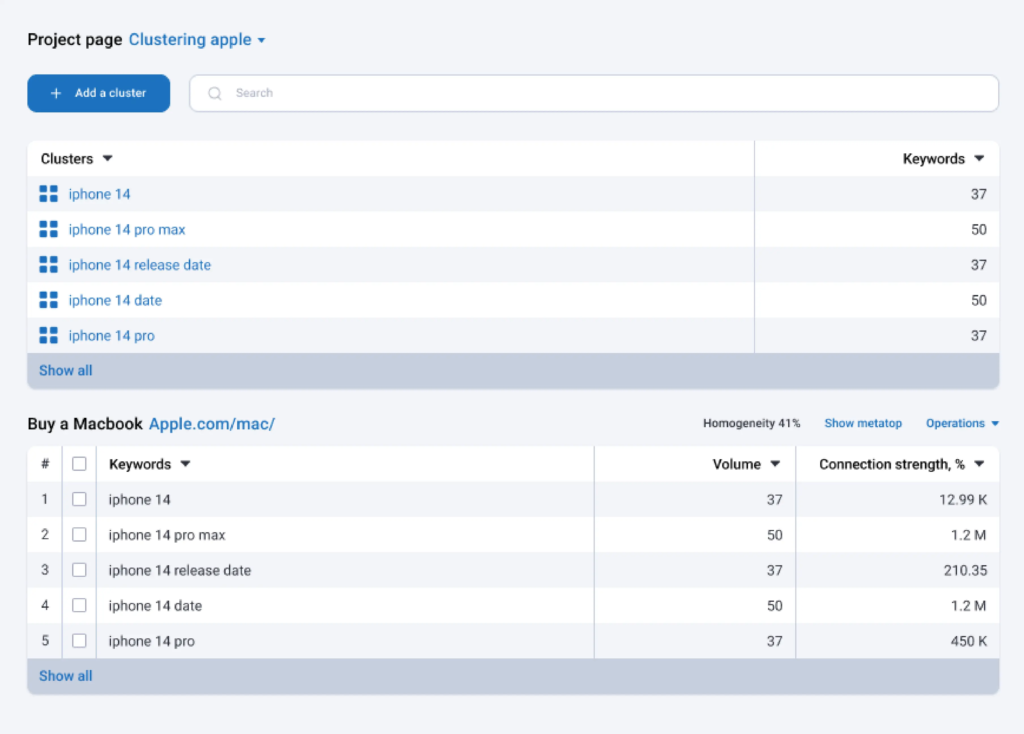
Comparing Semrush vs. Serpstat for Keyword Research
- Database and Accuracy: Semrush boasts a larger keyword database, offering broader global coverage. Serpstat, while slightly smaller, provides precise data with unique clustering features.
- User Interface: Both platforms offer user-friendly interfaces for keyword research, but Semrush’s Keyword Magic Tool is particularly noted for its ease of use and depth of data.
- Innovation in Keyword Discovery: Serpstat’s clustering and trends features present innovative ways to explore keyword opportunities, whereas Semrush excels in providing a comprehensive view of keyword landscapes, including competitive analysis.
- Value for Money: Considering the Semrush vs. Serpstat debate from a cost perspective, Serpstat offers significant value for its keyword research capabilities, especially for businesses with tighter budgets. Semrush, while more expensive, delivers extensive data and tools that can justify the investment for more extensive SEO campaigns.
Competitor Analysis
Competitor analysis is crucial for understanding your position in the market and identifying opportunities to improve your SEO strategy. When it comes to choosing the right tool for this task, the Semrush vs. Serpstat comparison offers insights into two of the most comprehensive tools available. Each has its strengths in helping businesses uncover valuable competitive intelligence. Here’s what you need to know:
Semrush Competitor Analysis Features
- Semrush provides an extensive overview of competitors’ strategies, including their traffic sources, rankings, and the keywords they’re targeting.
- It offers detailed insights into competitors’ backlink strategies, allowing you to discover new link-building opportunities.
- The Market Explorer feature gives an in-depth analysis of market trends, audience demographics, and competitor positioning.
- Semrush’s Competitive Positioning Map visualizes your competition in the digital space, helping identify key players.
Serpstat Competitor Analysis Features
- Serpstat allows users to track competitors’ rankings and identifies the keywords they are ranking for, which you may not be.
- It provides a comprehensive view of competitors’ advertising strategies and the keywords they bid on for PPC.
- The tool offers insights into competitors’ website traffic, including their most popular pages and how their search traffic has trended over time.
- Serpstat’s Tree-View feature lets you analyze competitors’ website structures to understand their content strategy.

Semrush vs. Serpstat: Diving Deeper into Competitor Analysis
- Data Coverage and Accuracy: Semrush is often praised for its vast database and the accuracy of its competitive intelligence, making it a preferred choice for businesses focusing on a global market. Serpstat, with strong coverage especially in Eastern European markets, offers precise data that can be incredibly valuable for targeting specific regions.
- User-Friendly Reporting: Both Semrush and Serpstat provide user-friendly interfaces, but Semrush’s reporting capabilities are particularly noteworthy for their depth and customization options, making it easier to translate data into actionable insights.
- Innovative Features: Serpstat’s Tree-View offers a unique approach to understanding a competitor’s content hierarchy, while Semrush’s Market Explorer provides broad market insights and trends that can inform strategic decisions.
- Value Proposition: Considering the Semrush vs. Serpstat debate from a value perspective, Serpstat provides a cost-effective solution for startups and small businesses, while Semrush, though higher in price, offers unmatched depth that can justify the investment for businesses with a strong focus on aggressive growth and market leadership.
Site Audit and On-Page SEO
A thorough site audit and effective on-page SEO are crucial for improving website performance and ranking. In the Semrush vs. Serpstat debate, both platforms offer robust tools to help webmasters identify and fix SEO issues. Understanding the capabilities of each tool in this area can help you make an informed decision on which is best suited for your needs.
Semrush Site Audit and On-Page SEO Features
- Semrush conducts an extensive site audit, checking for over 130 technical and SEO mistakes, including broken links, duplicate content, and issues with titles and descriptions.
- It offers an On-Page SEO Checker that provides actionable recommendations based on content and SEO best practices to improve page performance.
- The SEO Content Template in Semrush generates SEO-friendly content templates based on your keywords, suggesting ways to surpass competitors’ content.
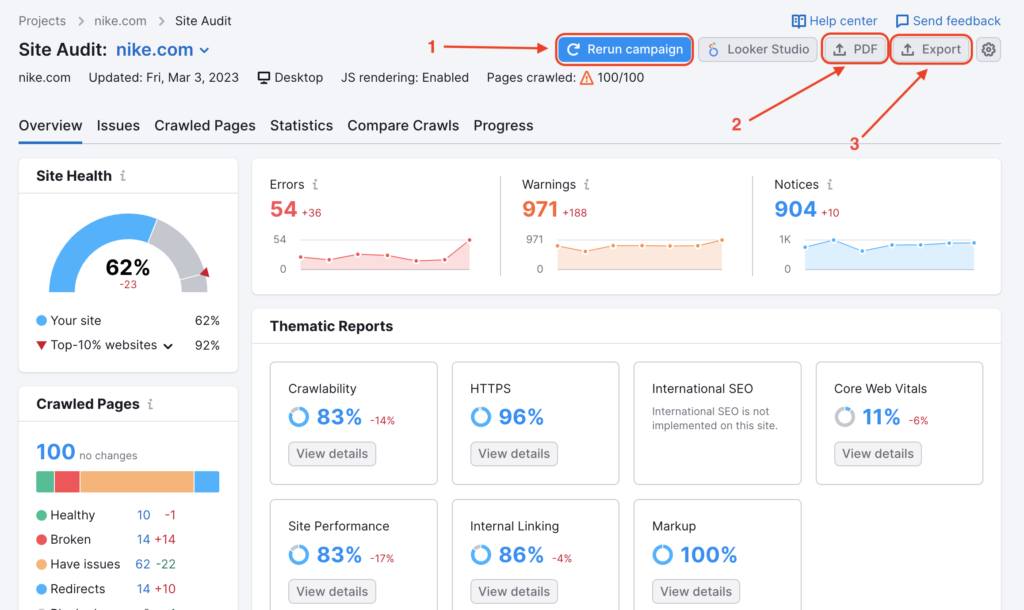
Serpstat Site Audit and On-Page SEO Features
- Serpstat performs a comprehensive site audit, highlighting issues like slow page loading, missing alt attributes, and HTTP status codes errors.
- It provides a Page Audit tool that offers detailed recommendations for individual pages, focusing on both technical SEO and content optimization.
- Serpstat’s unique selling point in on-page SEO is its ability to track and suggest improvements in real-time, focusing on both technical issues and content opportunities.
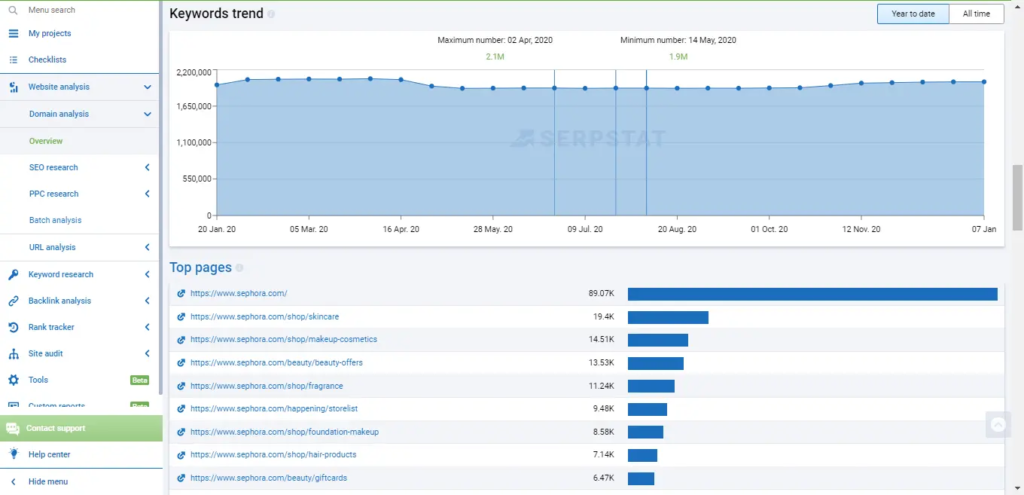
Semrush vs. Serpstat: Navigating Site Audit and On-Page SEO
- Depth and Breadth of Analysis: In the Semrush vs. Serpstat comparison, Semrush offers a broader scope in its site audit, checking for more potential issues. However, Serpstat provides detailed insights that are especially useful for on-the-go optimizations.
- User Experience: Both tools are designed with the user in mind, offering easy-to-understand reports and actionable insights. Semrush’s interface is particularly user-friendly, providing clear guidance on prioritizing and addressing issues.
- Content Optimization: Semrush stands out with its SEO Content Template, making it invaluable for content creators looking to optimize their pages based on competitive analysis. Serpstat’s real-time improvement suggestions are beneficial for quick on-page tweaks.
- Value for Investment: When considering Semrush vs. Serpstat for site audits and on-page SEO, your choice should reflect your specific needs and budget. Semrush might be more suitable for larger businesses or those with a broader web presence, while Serpstat offers a cost-effective solution for smaller sites or those just beginning to focus on SEO.
Backlink Analysis
Backlink analysis is pivotal for understanding the strength and quality of your site’s link profile, a key factor in SEO performance. The Semrush vs. Serpstat comparison sheds light on how each tool approaches backlink analysis, offering insights into which might best suit your needs for monitoring and improving your backlink strategy.
Semrush Backlink Analysis Features
- Semrush boasts one of the largest backlink databases, providing comprehensive insights into backlink profiles, including the total number of backlinks, referring domains, and types of backlinks (text, image, form, etc.).
- Offers detailed analytics on the authority of referring domains and the geographical distribution of backlinks.
- The Backlink Audit Tool helps identify potentially toxic links and offers options to manage and disavow them to protect your site’s SEO health.
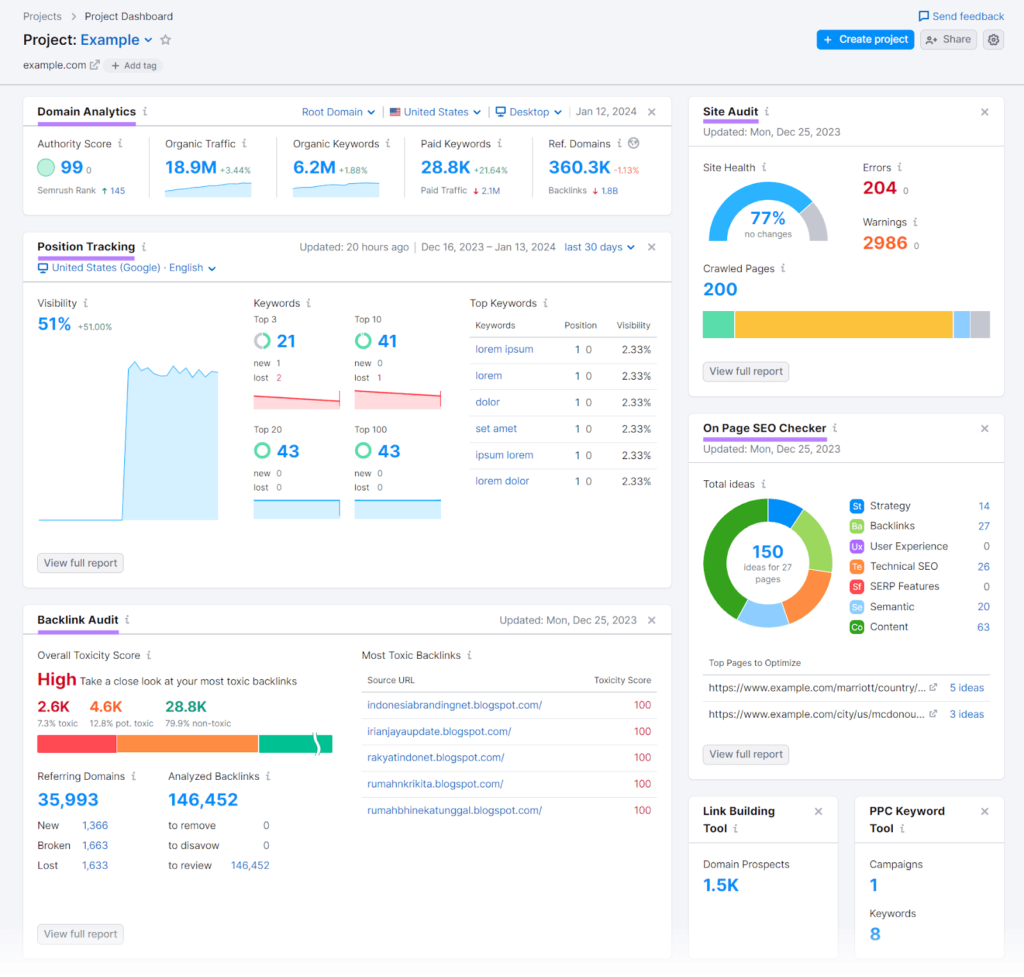
Serpstat Backlink Analysis Features
- Serpstat offers a robust tool for analyzing your website’s backlink profile, including new and lost backlinks, referring domains, and the visibility of linking pages.
- It provides insights into the anchor text distribution and the top pages by backlinks, helping to understand which content attracts the most links.
- Serpstat’s backlink index is updated regularly, ensuring that users have access to the most current data.
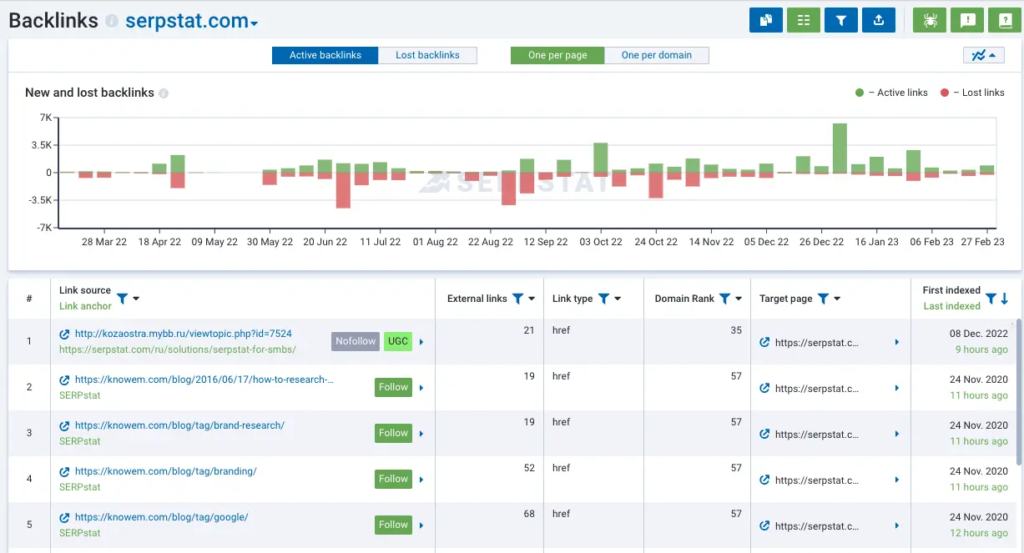
Semrush vs. Serpstat: Delving into Backlink Analysis
- Database Size and Update Frequency: In the Semrush vs. Serpstat face-off, Semrush is often recognized for its extensive backlink database and frequent updates, offering a broad view of your site’s backlink profile. Serpstat, while maintaining a smaller database, provides highly relevant and updated data, particularly useful for targeted analysis.
- Toxic Link Identification: Semrush’s Backlink Audit Tool is particularly noteworthy for its ability to identify and manage toxic backlinks, a feature that’s invaluable for maintaining your site’s SEO integrity.
- Analytical Depth: Both platforms provide deep analytical insights into backlinks, but Semrush offers a slightly more granular look at the authority and geographic distribution of backlinks, which can be crucial for global businesses.
- User Interface and Usability: Each tool presents its data in an accessible and user-friendly manner. Serpstat’s interface is straightforward and intuitive, making it easy for beginners to navigate, while Semrush offers detailed filtering options for advanced users.
Rank Tracking
Rank tracking is essential for SEO professionals and marketers aiming to understand their website’s performance in search engine results pages (SERPs). It provides insights into how effective your SEO strategies are and highlights areas for improvement. In the Semrush vs. Serpstat comparison, both tools offer comprehensive rank tracking capabilities, but they have different features that might make one more suitable for your needs than the other.
Semrush Rank Tracking Features
- Semrush allows users to track daily updates of keyword positions in the SERPs, including for mobile search and various geographical locations.
- It provides detailed reports on SERP features (like featured snippets, local pack listings) that your keywords are triggering.
- Semrush enables tracking of competitors’ keyword rankings alongside your own, offering valuable insights into your relative performance.
Serpstat Rank Tracking Features
- Serpstat offers rank tracking for Google and Yandex, updating positions daily for a comprehensive view of your search performance.
- It allows for the monitoring of keyword trends and identifies which pages are ranking for specific keywords, helping to fine-tune your SEO strategy.
- Serpstat provides detailed visibility and traffic forecasts based on current keyword positions, offering a projection of potential traffic gains from ranking improvements.
Semrush vs. Serpstat: Understanding Rank Tracking Nuances
- Data Granularity and Accuracy: In the Semrush vs. Serpstat battle for rank tracking supremacy, Semrush is often lauded for its high level of data granularity and accuracy, particularly for tracking across different regions and devices.
- Competitor Analysis: Both tools offer competitor rank tracking, but Semrush provides a more in-depth analysis, making it easier to benchmark your performance against competitors across a broad range of keywords and SERP features.
- Usability and Reporting: Semrush and Serpstat both have user-friendly interfaces with comprehensive reporting capabilities. However, Semrush’s reporting is particularly robust, offering customizable reports that can cater to various stakeholders.
- Value for Money: When evaluating Semrush vs. Serpstat with a focus on rank tracking, your choice might come down to budget considerations. Serpstat provides excellent value with its detailed rank tracking and forecasting at a more accessible price point, while Semrush, though more expensive, offers unmatched depth and breadth in rank tracking data.
Content Marketing Tools
In the digital age, content is king. However, creating content that not only resonates with your audience but also ranks well in search engine results requires sophisticated tools. The Semrush vs. Serpstat comparison provides insights into how each platform supports content marketers with their unique suite of tools. Here’s what you need to know about their content marketing capabilities.
Semrush Content Marketing Tools
- Semrush offers an extensive Content Marketing Platform that guides users through each step of the content workflow, from planning and creation to optimization and measurement.
- Features include the SEO Content Template, which provides recommendations on how to structure your content for SEO success based on top-performing competitors’ pages.
- The Brand Monitoring tool tracks your brand mentions across the web, helping you gauge the reach and impact of your content.
- Semrush’s Content Audit tool segments your site’s content to analyze performance and identify areas for improvement.

Serpstat Content Marketing Tools
- Serpstat is primarily known for its SEO and PPC capabilities, but it also offers features beneficial for content marketing, such as keyword research and competitor analysis tools that can inform content strategy.
- While it lacks a dedicated content marketing platform, Serpstat’s Search Questions feature helps identify popular questions related to your keywords, offering insights into potential content topics.
- Its Text Analytics tool can analyze your content’s relevance to targeted keywords, suggesting improvements to enhance SEO performance.
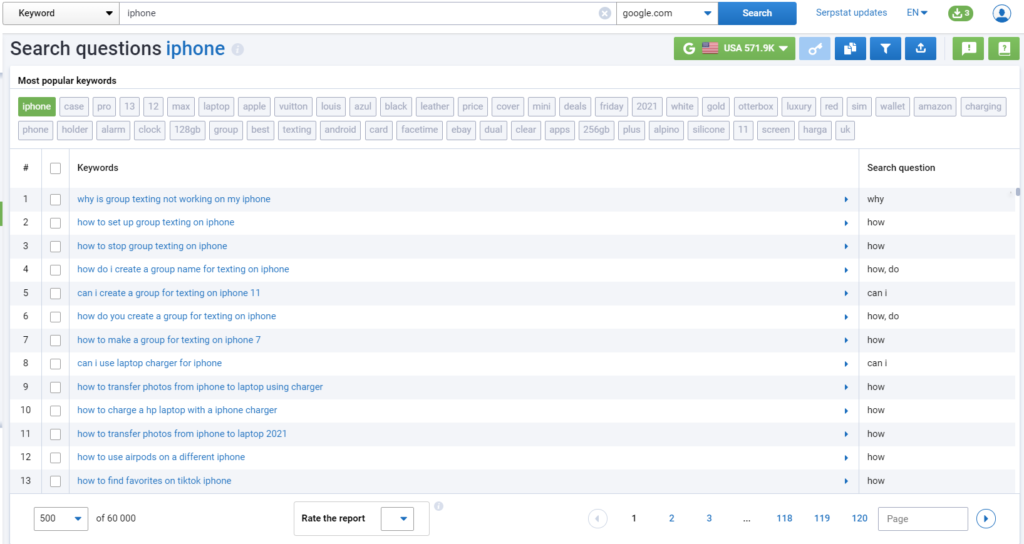
Semrush vs. Serpstat: Elevating Content Marketing Strategies
- Comprehensive vs. Specific Tools: In the Semrush vs. Serpstat debate, Semrush offers a more comprehensive suite of dedicated content marketing tools, making it a one-stop-shop for content marketers. Serpstat provides valuable tools for content research and optimization, albeit less specialized for content marketing.
- User Experience and Integration: Semrush’s integrated Content Marketing Platform provides a seamless experience for content strategy development, creation, and analysis. Serpstat’s offerings are more segmented, focusing on leveraging SEO insights for content optimization.
- Innovation and Support: Semrush continually innovates with tools like the Content Marketplace for creating and ordering content. Serpstat focuses on providing solid SEO and PPC insights that indirectly support content marketing efforts.
- Value for Money: Evaluating Semrush vs. Serpstat from a cost perspective, Semrush’s comprehensive tools reflect its higher price point, offering significant value for content marketers looking for an all-in-one solution. Serpstat, with its affordable pricing, is ideal for those who primarily need SEO insights to guide their content strategy.
User Interface and Ease of Use
In the vast landscape of SEO and content marketing tools, user interface (UI) and ease of use play crucial roles in determining the efficiency and productivity of digital marketers. The Semrush vs. Serpstat comparison offers insights into how each platform caters to users with their design and navigational structures, ensuring tools are not just powerful but also accessible.
Semrush User Interface and Ease of Use
- Semrush boasts a clean, intuitive interface that simplifies navigation through its extensive suite of tools. The dashboard is customizable, allowing users to prioritize the data and tools most relevant to their work.
- Tooltips and guided workflows are integrated throughout, making it easier for beginners to understand the functionalities and for experts to discover advanced features.
- The platform provides comprehensive learning resources, including tutorials and webinars, which enhance the user experience by ensuring users can fully leverage the tool’s capabilities.
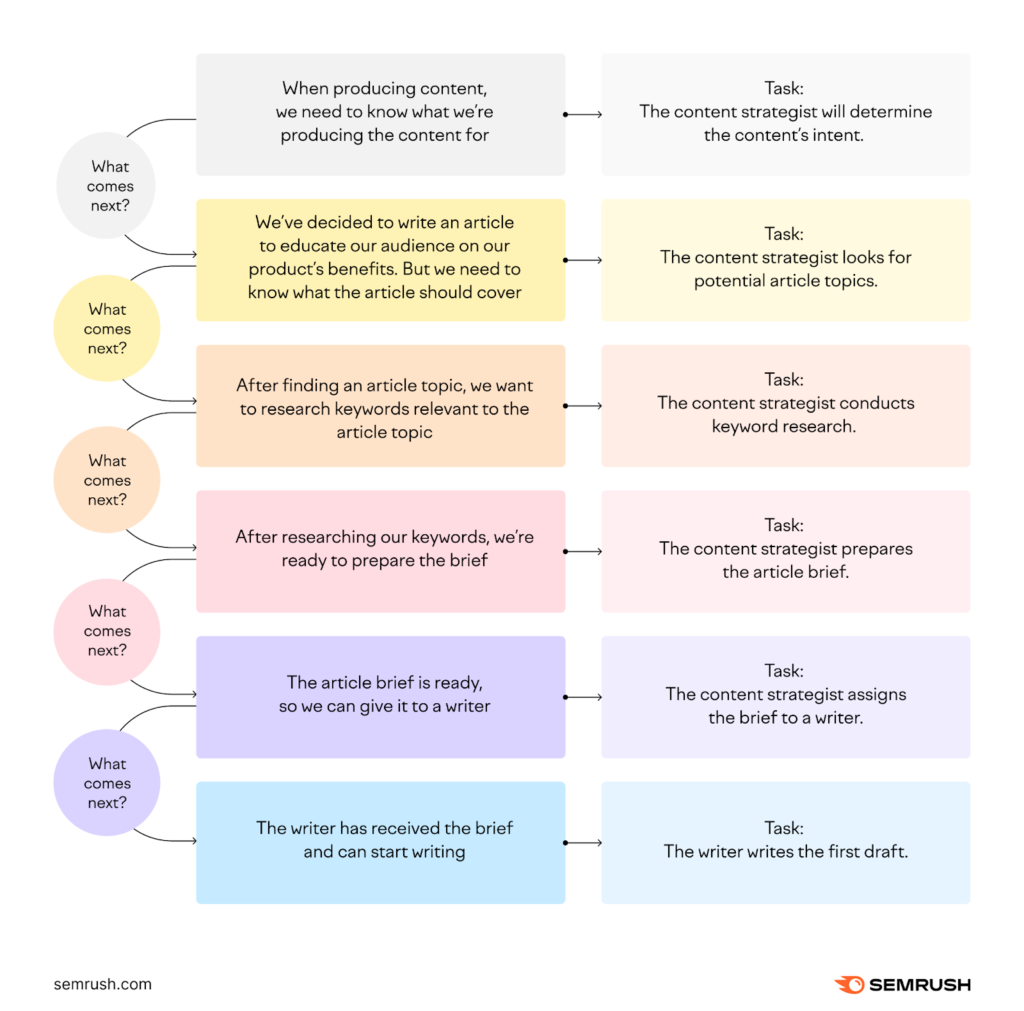
Serpstat User Interface and Ease of Use
- Serpstat offers a straightforward interface designed with the user in mind, ensuring that both SEO beginners and experts can navigate the platform without a steep learning curve.
- The tool’s layout is focused on providing quick access to its main features, like keyword research and site audit, from the main dashboard, facilitating efficient workflow.
- Serpstat also invests in educational resources, including a detailed blog and help center, to support users in maximizing the tool’s potential.

Semrush vs. Serpstat: Comparing User Experience
- Intuitiveness and Customization: In the Semrush vs. Serpstat showdown regarding UI, Semrush takes the lead in customization options and intuitive design that caters to both novice and professional users. Serpstat’s strength lies in its straightforwardness, appealing to users who appreciate simplicity and quick access to features.
- Learning Curve: Both platforms have a learning curve due to the depth of their offerings, but Semrush and Serpstat mitigate this with extensive educational materials. Semrush’s guided workflows are particularly beneficial for users new to SEO or the platform.
- Support and Resources: Semrush and Serpstat place a strong emphasis on user support through tutorials, blogs, and customer service. This focus on education enhances the overall ease of use by ensuring users have the resources needed to succeed.
- Adaptability: Both tools adapt to user feedback and evolving SEO best practices, regularly updating their interfaces and functionalities to improve user experience.
Customer Support
In the competitive world of SEO tools, the quality of customer support can significantly impact user satisfaction and success. Understanding how Semrush vs. Serpstat stack up in terms of customer support will help you choose the tool that not only fits your SEO needs but also provides the support you require to fully leverage its features.
Semrush Customer Support
- Semrush is renowned for its comprehensive customer support system. It offers multiple channels for support, including live chat, email, and phone, ensuring users can reach out through their preferred method.
- The platform also features a detailed knowledge base, including FAQs, user guides, and video tutorials, allowing users to find answers quickly to common questions.
- Semrush regularly hosts webinars and training sessions, providing users with opportunities to learn more about the platform and best practices in SEO and content marketing.

Serpstat Customer Support
- Serpstat offers a robust support system with live chat, email support, and a ticketing system. While it does not provide phone support, its live chat and email responses are timely and informative.
- Similar to Semrush, Serpstat has a comprehensive help center that includes articles, guides, and an FAQ section designed to help users navigate the platform and solve common issues.
- Serpstat also invests in user education through its blog, where it publishes updates, tips, and strategies for using its tools effectively.
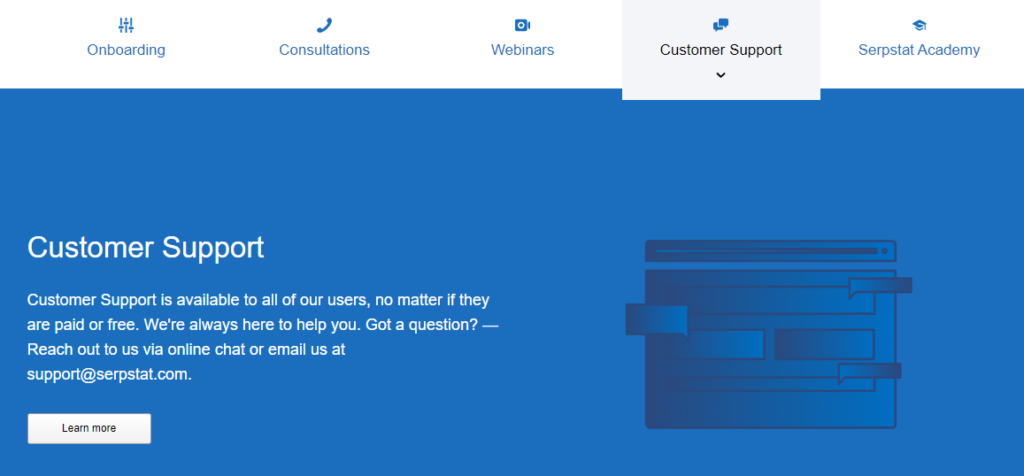
Semrush vs. Serpstat: Evaluating Customer Support
- Accessibility and Responsiveness: In the Semrush vs. Serpstat comparison, Semrush provides a slightly wider range of support options, including phone support, which can be crucial for urgent issues. Both platforms, however, are praised for their responsive and helpful support teams.
- Self-Help Resources: Both Semrush and Serpstat offer extensive self-help resources, including knowledge bases and video tutorials. This empowers users to find answers independently and learn at their own pace.
- Educational Content: Semrush takes a slight lead with its regular webinars and training sessions, which not only address platform-specific queries but also cover broader industry topics. Serpstat’s blog is a valuable resource for users looking to stay updated on SEO trends and platform capabilities.
- Community Engagement: Both tools have active communities, but Semrush’s engagement through webinars and global events fosters a sense of community and provides additional learning opportunities.
Integration
In today’s digital marketing landscape, the ability of an SEO tool to integrate with other platforms and services is crucial for streamlining workflows and maximizing efficiency. When comparing Semrush vs. Serpstat, it’s essential to understand how each tool fares in terms of integration capabilities, allowing users to connect their SEO efforts with other aspects of their digital marketing strategy.
Semrush Integration Capabilities
- Semrush offers a wide range of integration options with popular platforms such as Google Analytics, Google Search Console, and Google My Business, enabling users to consolidate their marketing data and gain more comprehensive insights.
- It also integrates with social media platforms like Facebook and Twitter for social media tracking and with task management tools such as Trello and Monday.com, facilitating project management and collaboration.
- Semrush’s API access allows for custom integration, letting businesses tailor the tool to their specific needs by pulling Semrush data into their custom dashboards or reports.
Serpstat Integration Capabilities
- Serpstat provides essential integration capabilities, focusing mainly on its API access, which enables users to extract Serpstat data for use in custom reports and applications, enhancing flexibility and personalization of data analysis.
- While it offers fewer direct integrations with third-party platforms compared to Semrush, Serpstat’s API is powerful for developers looking to build specialized tools or integrate with in-house systems.
Semrush vs. Serpstat: Analyzing Integration Strengths
- Range of Integration: In the Semrush vs. Serpstat competition, Semrush takes the lead with its broader array of direct integrations with external platforms, making it a more versatile tool for marketers who rely on multiple platforms for their digital strategies.
- Customization through API: Both Semrush and Serpstat offer API access for custom integration, though Semrush’s wider range of third-party integrations might be more appealing to users seeking ready-to-use connections without the need for custom development.
- Impact on Workflow: The integration capabilities of Semrush can significantly enhance workflow efficiency by automating data collection and analysis across various platforms. Serpstat’s strength lies in its adaptability through API access, catering to businesses with specific integration needs.
- Ease of Use: Direct integrations offered by Semrush are generally more user-friendly for those without technical expertise, enabling easy setup and use. Serpstat’s API-focused approach provides a powerful tool for those with the ability to utilize it, offering deep customization at the cost of a higher learning curve.
User Reviews
User reviews play a pivotal role in understanding the real-world application and effectiveness of digital marketing tools. When it comes to Semrush vs. Serpstat, analyzing what users have to say about each platform can offer insights beyond the technical specifications and feature lists, shedding light on user experience, customer service, and overall satisfaction. This exploration into user reviews aims to provide a balanced view of how both tools measure up in the eyes of their users.
Semrush User Reviews
Positive Feedback:
- Comprehensive Toolset: Users frequently commend Semrush for its wide range of features covering all aspects of digital marketing.
- Data Accuracy and Extensiveness: The vast and accurate data pool Semrush provides is often highlighted as a key advantage, enabling deep market analysis.
Constructive Criticism:
- Learning Curve: New users sometimes find Semrush’s extensive features overwhelming, noting a steeper learning curve.
- Pricing: Some reviews mention that Semrush can be pricey, especially for small businesses or individuals just starting out.
Serpstat User Reviews
Positive Feedback:
- Ease of Use: Many users highlight Serpstat’s user-friendly interface, making it accessible for beginners and professionals alike.
- Competitor Analysis: Reviews often praise Serpstat for its in-depth competitor insights, which users find invaluable for developing their SEO and PPC strategies.
Constructive Criticism:
- Data Breadth: Some users mention that while Serpstat is excellent for certain markets, it may offer less comprehensive data for other regions.
- Integration Limitations: A few reviews note that Serpstat’s integrations, although useful, are somewhat limited in scope compared to other platforms.
Semrush vs. Serpstat: Understanding User Perspectives
Diving into Semrush vs. Serpstat through user reviews illuminates the strengths and areas for improvement of each platform from a practical standpoint. Semrush is often celebrated for its comprehensive suite of tools and depth of data, appealing to users who need a wide-ranging, all-in-one digital marketing solution. On the other hand, Serpstat is lauded for its ease of use and focused competitor analysis, making it a favorite for users who value straightforward, actionable insights. Both platforms have their unique advantages and challenges as reflected by their users, highlighting the importance of aligning tool selection with specific marketing needs and preferences.
Conclusion: Semrush vs. Serpstat – Who Takes the Crown?
After a comprehensive exploration of Semrush vs. Serpstat across various dimensions including features, integration capabilities, user interface, customer support, and user reviews, it’s clear that each platform has its unique strengths and areas for improvement. Both tools offer valuable resources for digital marketers, but the choice between them ultimately hinges on your specific needs, preferences, and budget.
Semrush stands out with its extensive toolset, offering a deep dive into SEO, content marketing, competitor analysis, and more. Its wide array of features and integrations make it a powerful all-in-one solution for businesses looking to aggressively scale their digital marketing efforts. However, this comprehensiveness comes with a steeper learning curve and a higher price tag, which may be daunting for smaller businesses or individuals just starting out.
On the flip side, Serpstat is celebrated for its user-friendly interface and cost-effectiveness, making it an excellent choice for small to medium-sized businesses and those new to the SEO game. While it may not offer the same breadth of data as Semrush, its focused approach to SEO and PPC tools, combined with valuable competitor insights, makes it a strong contender for those prioritizing ease of use and affordability.
The Verdict
There is no one-size-fits-all answer in the Semrush vs. Serpstat debate. The “winner” depends on what you value most in your digital marketing tools:
- Choose Semrush if you’re looking for a comprehensive, data-driven approach to digital marketing and SEO, and are willing to invest in a premium tool that covers nearly every aspect of online marketing.
- Opt for Serpstat if you need an affordable, straightforward tool that provides essential SEO, PPC, and competitor analysis capabilities without overwhelming you with complexity.
In conclusion, both Semrush and Serpstat have proven to be formidable tools in the digital marketing space, each with its loyal following and success stories. By carefully considering your marketing goals, team’s expertise, and budget constraints, you can select the tool that best aligns with your strategy, ensuring your digital marketing efforts are both effective and efficient.




